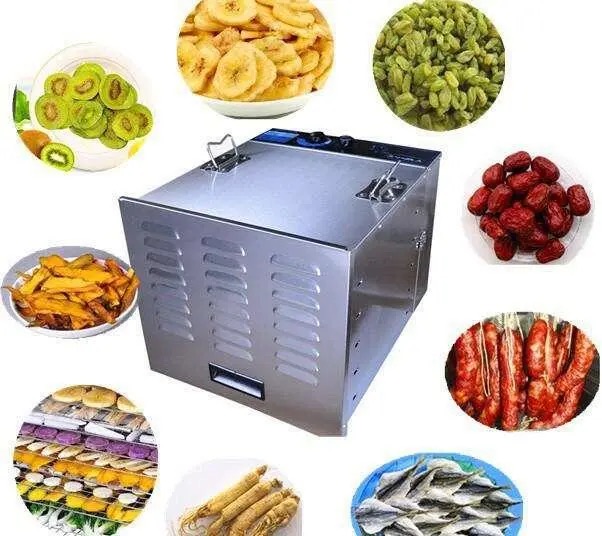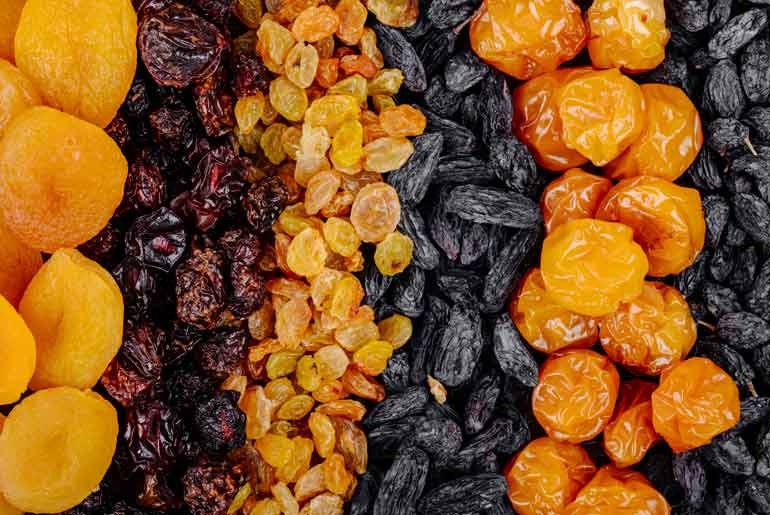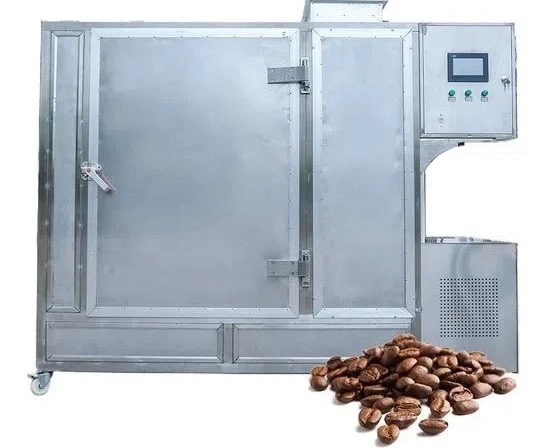
Content Menu
● Understanding the Importance of Food Drying
● Types of Industrial Food Dryers
>> Batch Dryers
>> Tunnel Dryers
>> Fluidized Bed Dryers
>> Spray Dryers
● Key Factors to Consider When Selecting a Food Dryer
>> Capacity and Production Volume
>> Energy Efficiency
>> Temperature Control and Range
>> Airflow and Moisture Removal
>> Material of Construction
>> Automation and Control Systems
● Advanced Features to Look For
>> Adjustable Thermostat
>> Timer and Auto Shut-Off
>> Multiple Tray Options
>> Hybrid Airflow Systems
● Emerging Technologies in Food Drying
>> Infrared Drying
>> Ultrasonic Drying
>> Vacuum Drying
● Customization and Scalability
>> Modular Systems
>> Custom Configurations
>> Pilot Testing
● Industry-Specific Considerations
>> Fruit and Vegetable Processing
>> Meat and Protein Products
>> Dairy Processing
● Environmental Impact and Sustainability
>> Energy Recovery Systems
>> Water Recycling
>> Eco-Friendly Refrigerants
● Training and Support
>> Operator Training
>> Technical Support
>> Documentation and Resources
● Conclusion
● FAQ
>> 1. What is the optimal temperature range for drying most foods?
>> 2. How do I determine the right capacity for my food drying needs?
>> 3. What are the advantages of a food dryer with multiple trays?
>> 4. How often should I clean and maintain my industrial food dryer?
>> 5. Can I use a food dryer for non-food items?
● Citations:
In the ever-evolving world of food processing, selecting the right drying solution is crucial for maintaining product quality, efficiency, and profitability. Whether you're a food manufacturer, distributor, or brand looking to optimize your production line, understanding the intricacies of industrial food dryers is essential. This comprehensive guide will delve into expert insights on choosing the best drying solutions for your specific needs.

Understanding the Importance of Food Drying
Food drying is a critical process in the food industry, serving to extend shelf life, enhance quality, and reduce transportation costs. By removing moisture from food products, manufacturers can prevent spoilage, preserve nutrients, and create new product offerings. The right drying solution can significantly impact your operation's efficiency and the final product's quality.
Types of Industrial Food Dryers
When it comes to industrial food dryers, there are several types to choose from, each offering unique features and benefits:
Batch Dryers
Ideal for smaller operations or specialized products, batch dryers process a set amount of food at a time. These are perfect for businesses that handle a variety of products or have limited production runs.
Tunnel Dryers
Tunnel dryers are excellent for continuous processing, making them suitable for large-scale operations. Food is placed on carts and moved through a long tunnel where heated air removes moisture.
Fluidized Bed Dryers
These dryers are perfect for granular or particulate foods. They use a stream of hot air to lift and separate food particles, ensuring uniform drying and high efficiency.
Spray Dryers
Commonly used for liquid foods like milk, spray dryers convert the liquid into a fine mist and dry it into a powder form. This method is ideal for creating instant food products.
Key Factors to Consider When Selecting a Food Dryer
Capacity and Production Volume
Assess your current and future production needs. Choose a dryer that can handle your required output without compromising on quality or efficiency. It's essential to consider not only your immediate needs but also potential growth in the coming years.
Energy Efficiency
Look for dryers with high energy efficiency ratings. This not only reduces operational costs but also aligns with sustainability goals. Modern dryers often come with energy-saving features such as heat recovery systems and improved insulation.
Temperature Control and Range
Different foods require different drying temperatures. Opt for a dryer with precise temperature control and a wide range to accommodate various products. Advanced systems may offer programmable temperature profiles for complex drying processes.
Airflow and Moisture Removal
Efficient airflow is crucial for even drying. Consider dryers with advanced airflow systems that ensure uniform moisture removal across all trays or sections. Some dryers feature adjustable airflow patterns to optimize drying for different product types.
Material of Construction
The construction material affects durability, ease of cleaning, and potential for contamination. Stainless steel is often preferred for its durability and hygienic properties. Look for food-grade materials that comply with industry standards and regulations.
Automation and Control Systems
Modern dryers come with advanced control systems that allow for precise monitoring and adjustment of drying parameters. This can lead to improved consistency and reduced labor costs. Some systems offer remote monitoring and control capabilities, enabling operators to manage the drying process from anywhere.

Advanced Features to Look For
Adjustable Thermostat
An adjustable thermostat allows for precise temperature control, which is crucial for maintaining product quality and consistency. Look for systems with digital controls and temperature readouts for accurate monitoring.
Timer and Auto Shut-Off
These features enhance convenience and safety, allowing the dryer to operate unattended while ensuring it stops at the right time. Programmable timers can be particularly useful for complex drying schedules.
Multiple Tray Options
The ability to add or remove trays provides flexibility in production volume and allows for drying different products simultaneously. Some dryers offer interchangeable tray materials for different product types.
Hybrid Airflow Systems
Some advanced dryers use a combination of vertical and horizontal airflow, ensuring even drying across all trays and reducing the need for rotation. This can significantly improve drying uniformity and efficiency.
Emerging Technologies in Food Drying
As the food industry continues to evolve, new drying technologies are emerging that promise improved efficiency and product quality:
Infrared Drying
Infrared drying uses electromagnetic radiation to heat food directly, potentially reducing drying times and energy consumption. This method can be particularly effective for thin products or surface drying.
Ultrasonic Drying
Ultrasonic technology can enhance traditional drying methods by creating microscopic vibrations that help break down the moisture barrier in foods. This can lead to faster drying times and improved product texture.
Vacuum Drying
Vacuum drying operates at lower temperatures, making it ideal for heat-sensitive products. By reducing air pressure, moisture can be removed at lower temperatures, helping to preserve delicate flavors and nutrients.
Customization and Scalability
When selecting a drying solution, consider the potential for customization and future scalability:
Modular Systems
Some manufacturers offer modular drying systems that can be expanded or reconfigured as your production needs change. This flexibility can be invaluable as your business grows.
Custom Configurations
For specialized products or unique processing requirements, look for suppliers who can provide custom-designed drying solutions. These may include specific tray designs, airflow patterns, or integration with existing production lines.
Pilot Testing
Before investing in a full-scale system, consider conducting pilot tests with smaller units. Many suppliers offer pilot-scale equipment that can help you optimize drying parameters and assess performance before scaling up.
Industry-Specific Considerations
Different sectors of the food industry may have unique requirements for their drying processes:
Fruit and Vegetable Processing
Fruit and vegetable processors often require dryers that can handle high moisture content and preserve color and nutritional value. Look for systems with gentle drying capabilities and options for pre-treatment processes like blanching.
Meat and Protein Products
Drying meat and protein products requires strict temperature control to ensure food safety. Consider dryers with advanced sanitation features and the ability to meet regulatory requirements for pathogen reduction.
Dairy Processing
Dairy processors, particularly those producing powdered milk or whey products, need dryers that can handle high-viscosity liquids and produce consistent particle sizes. Spray dryers with atomization options are often preferred in this sector.
Environmental Impact and Sustainability
As sustainability becomes increasingly important, consider the environmental impact of your drying solution:
Energy Recovery Systems
Look for dryers that incorporate energy recovery systems, such as heat exchangers, to recapture and reuse thermal energy from the exhaust air.
Water Recycling
For processes that involve significant moisture removal, consider systems that can collect and recycle the extracted water for other uses in your facility.
Eco-Friendly Refrigerants
If your drying process involves cooling or dehumidification stages, opt for systems that use environmentally friendly refrigerants with low global warming potential.
Training and Support
Proper training and ongoing support are crucial for getting the most out of your drying solution:
Operator Training
Ensure that the supplier offers comprehensive training programs for your operators. This should cover not only basic operation but also troubleshooting and maintenance procedures.
Technical Support
Look for suppliers that offer robust technical support, including remote diagnostics and rapid response times for on-site service when needed.
Documentation and Resources
Comprehensive user manuals, maintenance guides, and online resources can be invaluable for ongoing operation and troubleshooting.
Conclusion
Selecting the best drying solution for your food processing needs requires careful consideration of various factors, from capacity and energy efficiency to advanced features and sustainability. By understanding the different types of dryers available and the key factors to consider, you can make an informed decision that will optimize your production process and enhance product quality.
Remember, the right drying solution is an investment in your company's future. Take the time to research, consult with experts, and even conduct trials before making your final decision. With the right equipment and approach, you can significantly improve your food drying operations, leading to better products, increased efficiency, and ultimately, greater success in the competitive food industry.

FAQ
1. What is the optimal temperature range for drying most foods?
The optimal temperature range for drying most foods is between 130-160°F (54-71°C). However, this can vary depending on the specific food item. Herbs typically require lower temperatures around 90-100°F (32-38°C), while meats and jerky may need higher temperatures up to 160°F (71°C).
2. How do I determine the right capacity for my food drying needs?
To determine the right capacity, consider your current production volume and anticipated growth. Calculate the amount of food you need to dry per batch or per day, and choose a dryer that can handle this volume with some extra capacity for future expansion. It's often better to have slightly more capacity than you currently need to accommodate growth.
3. What are the advantages of a food dryer with multiple trays?
Food dryers with multiple trays offer several advantages:
- Increased capacity without taking up more floor space
- Ability to dry different foods simultaneously
- Flexibility to adjust capacity based on production needs
- Easier rotation of trays for even drying
- Option to remove trays for drying larger items
4. How often should I clean and maintain my industrial food dryer?
The frequency of cleaning and maintenance depends on usage and the type of food being dried. As a general rule:
- Clean trays and interior after each use
- Perform a deep clean weekly or bi-weekly
- Check and clean filters monthly
- Schedule professional maintenance annually
Regular maintenance ensures optimal performance, extends the life of your equipment, and maintains food safety standards.
5. Can I use a food dryer for non-food items?
While food dryers are primarily designed for food products, many models can be used for non-food items such as herbs, flowers, or crafts. However, it's important to dedicate separate trays or even separate machines for non-food items to prevent cross-contamination. Always check the manufacturer's guidelines before using your food dryer for non-food purposes.
Citations:
[1] https://www.dryeratech.com/7-tips-for-selecting-the-perfect-industrial-food-dryer-machine.html
[2] https://making.com/products/food/drying
[3] https://www.thespruceeats.com/best-food-dehydrators-4077285
[4] https://www.istockphoto.com/photos/food-dehydrator
[5] https://www.youtube.com/watch?v=A5Nf2P7-nbU
[6] https://www.youtube.com/watch?v=qtC36z0HleQ
[7] https://vrsupply.ca/blogs/buyers-guide/food-dehydrator-buyer-s-guide
[8] https://pleasanthillgrain.com/resources/dehydrators-buying-guide
[9] https://www.dreamstime.com/photos-images/food-dehydrator.html
[10] https://www.istockphoto.com/photos/food-dryer
[11] https://www.foodandwine.com/lifestyle/kitchen/best-food-dehydrators
[12] https://reads.alibaba.com/6-factors-consider-when-buying-industrial-dryer/
[13] https://extension.psu.edu/lets-preserve-drying-fruits-and-vegetables-dehydration
[14] https://www.youtube.com/watch?v=8XID-nxU5K0
[15] https://excaliburdehydrator.com
[16] https://www.youtube.com/watch?v=rR2G5UO-5Ms
[17] https://hgic.clemson.edu/factsheet/drying-foods/
[18] https://machine.goldsupplier.com/blog/mushroom-dryer-machine/
[19] https://www.healthycanning.com/food-drying-methods
[20] https://www.youtube.com/watch?v=lEUA2t2XD5M
[21] https://www.dehydratorsamerica.com/category/industrial-food-dehydrators
[22] https://www.youtube.com/watch?v=mtDzdYoyeR8











